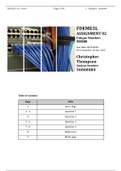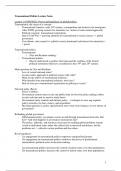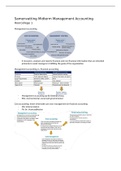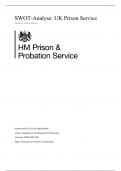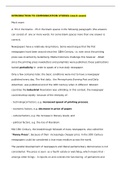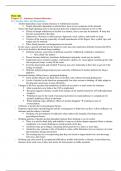Melanie Koster
International Strategy (2020 – 2021) – Article Summary
Article 1: Verbeke, A., & Asmussen, C. G. (2016). Global, local, or regional? The locus of MNE strategies.
Journal of Management Studies, 53(6), 1051-1075.
FSAs = Firm Specific Advantages.
A common perception in the international strategy field, and in society at large, is that internationally
operating firms pursue – or should pursue – ‘global’ strategies in terms of scanning the world for business
opportunities and responding to such opportunities with a broad geographic deployment of their ‘non-
location-bound’ FSAs.
The foundation of new FSA generation has been challenged based on the problems of bounded rationality
(BRat) and bounded reliability (BRel).
The Fortune Global 500 firms had the bulk of their sales in the home region, suggesting a limited ‘non-
location boundedness’ of these large MNEs’ FSAs.
MNEs do have a strong home region bias in their expansion patterns.
THE REGION AS LOCUS OF INTERNATIONAL STRATEGY
Mainstream international strategy research builds on the observation that successful international
expansion must be associated with at least some type of non-location bound FSAs. These are FSAs that can
be transferred, deployed and exploited across borders.
builds on the observation that successful international expansion must be associated with at least some
type of non-location bound FSAs. These are FSAs that can be transferred, deployed and exploited across
borders.
Non-location bound FSAs can be embodied in final products (typically leading to exports), or shared across
the MNE network (typically leading to foreign subsidiaries being established, whether in the form of wholly
owned operations or equity joint ventures), or exploited through contracting with third parties (as is the
case with licensing, production agreements, etc.).
Irrespective of how non-location bound FSAs are transferred, such FSAs can lead to three types of ‘benefits
of integration’:
1. Economies of scale (from concentrating specific activities in one location);
2. Economies of scope (from sharing resources across borders, especially knowledge and governance-
related resources such as shared accounting and ICT related practices);
3. Economies of exploiting national differences (from distributing the value chain across borders and
then coordinating these geographically dispersed activities).
Only in exceptional circumstances does global success materialize easily and rapidly ! demand & supply
side components:
- Demand side: instant global interest from internationally dispersed customers for a niche market
product combined with low marketing mix adaptation requirements and low cost means of
marketing and delivery, can increase the non-location boundedness of FSAs.
- Supply side: advanced technology or service offering, duly protected from competitive imitation,
will have a similar effect.
, Melanie Koster
Linking investments must typically be made by the MNE to blend extant resources with locally accessible
ones held by host country resource owners, thereby driving the creation of new, location-bound FSAs in
host countries, i.e., an ability to be nationally responsive in critical areas of the value chain.
! A successful international strategy in terms of achieving profitable growth entails careful selectivity as
to where and how the firm should expand (where regional dimension comes in).
Regional Integration/Responsiveness ! designed as the sphere of ‘semi-globalization’.
Region = a grouping of countries that are relatively similar to each other and relatively dissimilar to
countries in other regions.
Two research approaches to assess semi-globalization and the role of the region in MNE strategy:
1. FSAs are viewed as region-bound, in the sense of having limited exploitation potential outside of
the home region: both the strength of the MNE’s FSAs and the spatial transaction costs associated
with their transfer, deployment and exploitation are moderated by regional boundaries.
Positive/predictive level: challenge to explain the simple observation that home-region
diversification is a prevalent mode of internationalization. Home-region diversification is ‘preferred’
over global diversification in most ‘real world’ situational contexts.
Normative level: firms ‘over-diversified’ geographically and are expected to exhibit a weaker
performance as a consequence. Systematic bias such as overestimating the inter-regional
transferability, deployability and exploitation potential of FSAs may be instrumental to lower
performance outside of the home region.
2. Focus is on how firms that have already expanded into host regions adapt to a world where
regional barriers to full, global integration continue to exist. The limited possibilities are
acknowledged for many firms to earn ‘global’ scale economies, scope economies, and benefits of
exploiting national differences.
, Melanie Koster
RESEARCH PERSPECTIVES ON THE ROLE OF THE REGION IN INTERNATIONAL STRATEGY
Internalization Theory and Regional Boundaries
Firms-specific advantages and regional strategy:
A regional strategy research agenda arises precisely because of substantial discontinuous at the regional
boundary ! distance between countries forming a region and those outside of it represents a quantum
leap as compared to intra-regional distance (geography issue).
In addition to geography, however, cultural, economic, and institutional elements can play equally strong
roles, and, most importantly, it is the inter-relatedness among these dimensions that causes a spike in
compounded distance at the regional border.
Overarching regional institutions can, through the freer flow of human and financial resources as well as
goods and intellectual property, foster more commonality in cultural values relevant to business and also
reduce economic distance.
Barriers to profitable growth may be raised for regional outsiders relative to insiders (free trade
agreements, monetary unions etc.). However, the magnitude of the business opportunity, elevated from
the country level to the regional one, may also increase for the outsiders.
It has also been observed that MNE operating mode choices are altered, because in cases of far-reaching
economic and political integration such as the EMU (European Monetary Union), national institutional risk
becomes irrelevant to operating mode selection by insider firms.
MNEs commanding FSAs with supposedly global reach can now ‘fine- tune’ such FSAs further, i.e., engage
in some form of regional responsiveness, again leading to region-bound FSAs with stronger actionable
potential than before to capture regional scale and scope economies and benefits of exploiting national
differences within the region.
Adaptation to the requirements of a particular geographic area may not have been viewed as feasible or
economically viable before, but now becomes feasible and viable because of regional integration, thereby
potentially allowing an increase in size of the firm’s footprint in the relevant host region.
RBV component of internalization theory ! points to the limits of international diversification.
Firms’ resource bundles typically lead to more profitable growth opportunities in the home region than in
host regions, because of the comparatively stronger similarity between the home country environment
and that of other countries in the home region.
Spatial transaction costs and regional strategy:
TCE dimension of internalization theory ! FSAs must be protected through economizing mechanisms.
Given imperfect information and limited information processing capacity, seeking profitable growth inside
the home region, i.e., inside ‘low compounded distance’ countries, would appear consistent with the need
to economize on bounded rationality (BRat or ‘scarcity of mind’).
Lower compounded distance = more intra-regional similarities both among country environments and
among the configurations of firm-level activity sets conducted in the relevant countries.
Reduces spatial transactions costs and fosters a home-region strategy approach.
Firm-level ! quasi-identical human resources management, after-sales service routines etc.
Result: bounded reliability challenges (BRel or ‘scarcity of making good on open ended promises’) inside
the home region can also be substantially reduced vis-à-vis outsider regions.
, Melanie Koster
Challenges when trying to achieve profitable growth in host regions:
1. Bundle extant FSAs with requisite resources in these environments.
2. Spatial transaction costs and related, necessary linking investments are substantially higher than in
the home region, and the effectiveness thereof much more uncertain, because of BRat and BRel
challenges (a TCE related issue).
The dangers of geographic overstretching
Overstretching !
- Would reflect ‘mistakes’ such as MNE managers’ exaggerated belief in the transferability,
deployability and profitable exploitation of allegedly non-location bound FSAs, meaning that these
FSAs are really home-region-bound;
- Could also mean underestimating the magnitude of the linking investments needed to meld extant
resources with new ones, as a pre-condition for new FSA creation;
- Could simply mean that the geographic scope of the firm’s activities is too broad for efficient
governance to occur, given that the existing governance mechanisms were designed to address
only limited compounded distance. Here, the internal, spatial transaction costs related to global
expansion are underestimated.
Overstretching results in:
Short/medium term ! reduction in performance.
Long term ! firms would correct their excessively high level of geographic diversification.
A potentially promising angle in this context is the analysis of the trade-offs between increasing product
diversification versus inter-regional geographic diversification, since governance problems related to BRat
and Brel may arise in both cases.
S-curve thinking = performance is supposed to go down in a first stage of international expansion, inter alia
because of spatial transaction costs. In a subsequent, second stage with a focus on home-region expansion,
the M-P (multinational – performance) relationship is hypothesized to be positive, inter alia because of
easily achievable scale and scope economies, as well as benefits of exploiting national differences.
However, further expansion beyond the home region could negatively affect performance, since
‘coordination and governance costs escalate due to the increasing complexity and diversity of knowledge,
business practices and consumer tastes that the company encounters’.
It is reasonable to assume that firms engaged in international expansion beyond their home region do so
because of the non-location bound FSAs they command, which is a cornerstone of mainstream
internalization theory.
Issue ! ‘value’ of these FSAs does not remain stable.
An inter-regional footprint may give the MNE more flexibility in its decision-making and thereby confers
value when regions evolve differently over time.
Because of BRat, both the magnitude of spatial transaction costs (and associated requisite new resource
recombination) and the option value of particular decisions to enter a specific region, may only become
apparent ex post, after initial investments in the region have been completed.
Importantly, the effects on performance of inter-regional diversification will at least partly be determined
by managerial biases (typically in the sense of underestimating spatial transaction costs and overestimating
the global reach of FSAs), by unpredictable external shocks, and by differences in the macro-level evolution
of the home versus host regions.
International Strategy (2020 – 2021) – Article Summary
Article 1: Verbeke, A., & Asmussen, C. G. (2016). Global, local, or regional? The locus of MNE strategies.
Journal of Management Studies, 53(6), 1051-1075.
FSAs = Firm Specific Advantages.
A common perception in the international strategy field, and in society at large, is that internationally
operating firms pursue – or should pursue – ‘global’ strategies in terms of scanning the world for business
opportunities and responding to such opportunities with a broad geographic deployment of their ‘non-
location-bound’ FSAs.
The foundation of new FSA generation has been challenged based on the problems of bounded rationality
(BRat) and bounded reliability (BRel).
The Fortune Global 500 firms had the bulk of their sales in the home region, suggesting a limited ‘non-
location boundedness’ of these large MNEs’ FSAs.
MNEs do have a strong home region bias in their expansion patterns.
THE REGION AS LOCUS OF INTERNATIONAL STRATEGY
Mainstream international strategy research builds on the observation that successful international
expansion must be associated with at least some type of non-location bound FSAs. These are FSAs that can
be transferred, deployed and exploited across borders.
builds on the observation that successful international expansion must be associated with at least some
type of non-location bound FSAs. These are FSAs that can be transferred, deployed and exploited across
borders.
Non-location bound FSAs can be embodied in final products (typically leading to exports), or shared across
the MNE network (typically leading to foreign subsidiaries being established, whether in the form of wholly
owned operations or equity joint ventures), or exploited through contracting with third parties (as is the
case with licensing, production agreements, etc.).
Irrespective of how non-location bound FSAs are transferred, such FSAs can lead to three types of ‘benefits
of integration’:
1. Economies of scale (from concentrating specific activities in one location);
2. Economies of scope (from sharing resources across borders, especially knowledge and governance-
related resources such as shared accounting and ICT related practices);
3. Economies of exploiting national differences (from distributing the value chain across borders and
then coordinating these geographically dispersed activities).
Only in exceptional circumstances does global success materialize easily and rapidly ! demand & supply
side components:
- Demand side: instant global interest from internationally dispersed customers for a niche market
product combined with low marketing mix adaptation requirements and low cost means of
marketing and delivery, can increase the non-location boundedness of FSAs.
- Supply side: advanced technology or service offering, duly protected from competitive imitation,
will have a similar effect.
, Melanie Koster
Linking investments must typically be made by the MNE to blend extant resources with locally accessible
ones held by host country resource owners, thereby driving the creation of new, location-bound FSAs in
host countries, i.e., an ability to be nationally responsive in critical areas of the value chain.
! A successful international strategy in terms of achieving profitable growth entails careful selectivity as
to where and how the firm should expand (where regional dimension comes in).
Regional Integration/Responsiveness ! designed as the sphere of ‘semi-globalization’.
Region = a grouping of countries that are relatively similar to each other and relatively dissimilar to
countries in other regions.
Two research approaches to assess semi-globalization and the role of the region in MNE strategy:
1. FSAs are viewed as region-bound, in the sense of having limited exploitation potential outside of
the home region: both the strength of the MNE’s FSAs and the spatial transaction costs associated
with their transfer, deployment and exploitation are moderated by regional boundaries.
Positive/predictive level: challenge to explain the simple observation that home-region
diversification is a prevalent mode of internationalization. Home-region diversification is ‘preferred’
over global diversification in most ‘real world’ situational contexts.
Normative level: firms ‘over-diversified’ geographically and are expected to exhibit a weaker
performance as a consequence. Systematic bias such as overestimating the inter-regional
transferability, deployability and exploitation potential of FSAs may be instrumental to lower
performance outside of the home region.
2. Focus is on how firms that have already expanded into host regions adapt to a world where
regional barriers to full, global integration continue to exist. The limited possibilities are
acknowledged for many firms to earn ‘global’ scale economies, scope economies, and benefits of
exploiting national differences.
, Melanie Koster
RESEARCH PERSPECTIVES ON THE ROLE OF THE REGION IN INTERNATIONAL STRATEGY
Internalization Theory and Regional Boundaries
Firms-specific advantages and regional strategy:
A regional strategy research agenda arises precisely because of substantial discontinuous at the regional
boundary ! distance between countries forming a region and those outside of it represents a quantum
leap as compared to intra-regional distance (geography issue).
In addition to geography, however, cultural, economic, and institutional elements can play equally strong
roles, and, most importantly, it is the inter-relatedness among these dimensions that causes a spike in
compounded distance at the regional border.
Overarching regional institutions can, through the freer flow of human and financial resources as well as
goods and intellectual property, foster more commonality in cultural values relevant to business and also
reduce economic distance.
Barriers to profitable growth may be raised for regional outsiders relative to insiders (free trade
agreements, monetary unions etc.). However, the magnitude of the business opportunity, elevated from
the country level to the regional one, may also increase for the outsiders.
It has also been observed that MNE operating mode choices are altered, because in cases of far-reaching
economic and political integration such as the EMU (European Monetary Union), national institutional risk
becomes irrelevant to operating mode selection by insider firms.
MNEs commanding FSAs with supposedly global reach can now ‘fine- tune’ such FSAs further, i.e., engage
in some form of regional responsiveness, again leading to region-bound FSAs with stronger actionable
potential than before to capture regional scale and scope economies and benefits of exploiting national
differences within the region.
Adaptation to the requirements of a particular geographic area may not have been viewed as feasible or
economically viable before, but now becomes feasible and viable because of regional integration, thereby
potentially allowing an increase in size of the firm’s footprint in the relevant host region.
RBV component of internalization theory ! points to the limits of international diversification.
Firms’ resource bundles typically lead to more profitable growth opportunities in the home region than in
host regions, because of the comparatively stronger similarity between the home country environment
and that of other countries in the home region.
Spatial transaction costs and regional strategy:
TCE dimension of internalization theory ! FSAs must be protected through economizing mechanisms.
Given imperfect information and limited information processing capacity, seeking profitable growth inside
the home region, i.e., inside ‘low compounded distance’ countries, would appear consistent with the need
to economize on bounded rationality (BRat or ‘scarcity of mind’).
Lower compounded distance = more intra-regional similarities both among country environments and
among the configurations of firm-level activity sets conducted in the relevant countries.
Reduces spatial transactions costs and fosters a home-region strategy approach.
Firm-level ! quasi-identical human resources management, after-sales service routines etc.
Result: bounded reliability challenges (BRel or ‘scarcity of making good on open ended promises’) inside
the home region can also be substantially reduced vis-à-vis outsider regions.
, Melanie Koster
Challenges when trying to achieve profitable growth in host regions:
1. Bundle extant FSAs with requisite resources in these environments.
2. Spatial transaction costs and related, necessary linking investments are substantially higher than in
the home region, and the effectiveness thereof much more uncertain, because of BRat and BRel
challenges (a TCE related issue).
The dangers of geographic overstretching
Overstretching !
- Would reflect ‘mistakes’ such as MNE managers’ exaggerated belief in the transferability,
deployability and profitable exploitation of allegedly non-location bound FSAs, meaning that these
FSAs are really home-region-bound;
- Could also mean underestimating the magnitude of the linking investments needed to meld extant
resources with new ones, as a pre-condition for new FSA creation;
- Could simply mean that the geographic scope of the firm’s activities is too broad for efficient
governance to occur, given that the existing governance mechanisms were designed to address
only limited compounded distance. Here, the internal, spatial transaction costs related to global
expansion are underestimated.
Overstretching results in:
Short/medium term ! reduction in performance.
Long term ! firms would correct their excessively high level of geographic diversification.
A potentially promising angle in this context is the analysis of the trade-offs between increasing product
diversification versus inter-regional geographic diversification, since governance problems related to BRat
and Brel may arise in both cases.
S-curve thinking = performance is supposed to go down in a first stage of international expansion, inter alia
because of spatial transaction costs. In a subsequent, second stage with a focus on home-region expansion,
the M-P (multinational – performance) relationship is hypothesized to be positive, inter alia because of
easily achievable scale and scope economies, as well as benefits of exploiting national differences.
However, further expansion beyond the home region could negatively affect performance, since
‘coordination and governance costs escalate due to the increasing complexity and diversity of knowledge,
business practices and consumer tastes that the company encounters’.
It is reasonable to assume that firms engaged in international expansion beyond their home region do so
because of the non-location bound FSAs they command, which is a cornerstone of mainstream
internalization theory.
Issue ! ‘value’ of these FSAs does not remain stable.
An inter-regional footprint may give the MNE more flexibility in its decision-making and thereby confers
value when regions evolve differently over time.
Because of BRat, both the magnitude of spatial transaction costs (and associated requisite new resource
recombination) and the option value of particular decisions to enter a specific region, may only become
apparent ex post, after initial investments in the region have been completed.
Importantly, the effects on performance of inter-regional diversification will at least partly be determined
by managerial biases (typically in the sense of underestimating spatial transaction costs and overestimating
the global reach of FSAs), by unpredictable external shocks, and by differences in the macro-level evolution
of the home versus host regions.


